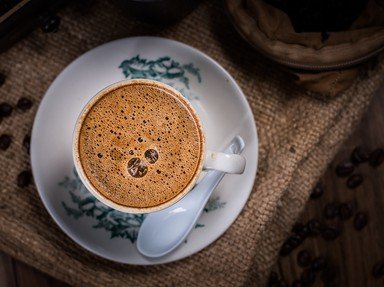Quiz Answer Key and Fun Facts
1. Do you believe that before you put it in your body you should know something about it? Well, let's see what you know about the humble beginnings of coffee.
Of course, as with so many things, there are always exceptions but how does the majority of coffee start out?
2. In North America we all know when the waitress shows up at the table with an orange spout and handle on the coffee pot, she's about to pour us decaf, coffee with reduced caffeine. But what exactly is caffeine?
3. The process of getting coffee seeds from tree to roaster is actually pretty simple. Machines can't do it, so workers pick ripe cherries from the trees and those cherries are split to get the two coffee seeds inside. Once the seeds are out, they are immediately sent to a factory to be roasted. Do I have this right?
4. Most coffee is roasted before it is sold and roasting is the next process that the coffee seeds/beans go through. Which of the following statements about the roasting process and the beans is NOT true?
5. Coffee is popular all over the world, second only to water, but it's not grown all over the world. Which of these countries do you imagine imports the most coffee? (Overall, not per capita)
6. Who do you suppose exports the most bags of coffee? Brazil is number one but which of these countries do you think is number two?
7. We've picked the cherries, dried the seeds, roasted and ground the beans, and exported the coffee, now it's time to brew some. For most coffee, there are four methods to making a good cup; which of the following is NOT a method?
8. No more delays, we've learned about the four methods so now it's time to choose a container and brew a cup of java, mud, or joe. By the way, where in the world did that slang term or nickname 'joe' come from?
9. We're really going to get brewing now. I'm just not sure what contraption to use. I'll let you decide. All you have to do is find the fake among the actual brewers listed below.
10. I'm ready to sit back and relax with my steaming cup of brown nectar, but my kids just ran in the house and are begging for a cup of coffee. I'll just tell them 'no'. There are plenty of recent studies that have proved that coffee is bad for children, even in small amounts. Right?
Source: Author
suzi_greer
This quiz was reviewed by FunTrivia editor
WesleyCrusher before going online.
Any errors found in FunTrivia content are routinely corrected through our feedback system.
